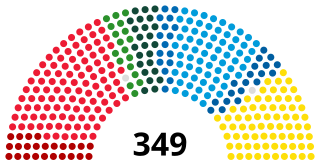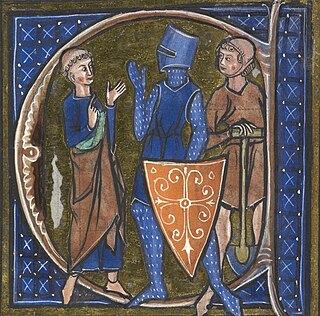General elections were held in Sweden in 1869 to elect the Second Chamber of the Riksdag for a three-year term. In urban areas the elections were direct, whilst in some rural areas the vote was indirect, using electors.
 |
|---|
General elections were held in Sweden in 1869 to elect the Second Chamber of the Riksdag for a three-year term. In urban areas the elections were direct, whilst in some rural areas the vote was indirect, using electors.
Suffrage was given to men over the age of 21 who either had a taxable income of at least 800 riksdaler a year, owned a property worth at least 1,000 riksdaler, or rented a property taxed to at least 6,000 riksdaler. [1]
The Second Chamber had one representative from every Domsaga (or two for Domsaga with a population over 40,000) and one representative for every 10,000 residents of a town (with smaller towns merged into combined constituencies). [1] Candidates were required to be at least 25 years old. [1]

Suffrage, political franchise, or simply franchise is the right to vote in public, political elections and referendums. In some languages, and occasionally in English, the right to vote is called active suffrage, as distinct from passive suffrage, which is the right to stand for election. The combination of active and passive suffrage is sometimes called full suffrage.

The Riksdag is the legislature and the supreme decision-making body of the Kingdom of Sweden. Since 1971, the Riksdag has been a unicameral legislature with 349 members, elected proportionally and serving, since 1994, fixed four-year terms. The 2022 Swedish general election is the most recent general election.
The period following the accession of Oscar II to the throne of Sweden in 1872 was marked by political conflict. The Lantmanna Party, representing peasant proprietors, dominated the Lower House of parliament, and demanded tax reductions and reforms of the system of military service. The Upper House opposed these positions. A compromise was reached in 1884 with reduction in land taxes and increased periods of military service, processes that continued in later years.

The estates of the realm, or three estates, were the broad orders of social hierarchy used in Christendom from the Middle Ages to early modern Europe. Different systems for dividing society members into estates developed and evolved over time.

The Texas Legislature is the state legislature of the U.S. state of Texas. It is a bicameral body composed of a 31-member Senate and a 150-member House of Representatives. The state legislature meets at the Capitol in Austin. It is a powerful arm of the Texas government not only because of its power of the purse to control and direct the activities of state government and the strong constitutional connections between it and the Lieutenant Governor of Texas, but also due to Texas's plural executive.

The Indiana General Assembly is the state legislature, or legislative branch, of the U.S. state of Indiana. It is a bicameral legislature that consists of a lower house, the Indiana House of Representatives, and an upper house, the Indiana Senate. The General Assembly meets annually at the Indiana Statehouse in Indianapolis.

The Kingdom of Saxony was a German monarchy that existed in Central Europe between 1806 to 1918. The territory of the Kingdom comprised from the former Electorate of Saxony. A member of historical confederacies, it joined the Confederation of the Rhine after the dissolution of the Holy Roman Empire, later joining the German Confederation after Napoleon was defeated in 1815. From 1871, it was part of the German Empire. It became a free state in the era of Weimar Republic in 1918 after the end of World War I and the abdication of King Frederick Augustus III of Saxony. Its capital was the city of Dresden, and its modern successor state is the Free State of Saxony.

The Prussian three-class franchise was an indirect electoral system used from 1848 until 1918 in the Kingdom of Prussia and for shorter periods in other German states. Voters were grouped by district into three classes, with the total tax payments in each class equal. Those who paid the most in taxes formed the first class, followed by the next highest in the second, with those who paid the least in the third. Voters in each class separately elected one third of the electors who in turn voted for the representatives. Voting was not secret. The franchise was a form of apportionment by economic class rather than geographic area or population.
The State of New Hampshire has a republican form of government modeled after the Government of the United States, with three branches: the executive, consisting of the Governor of New Hampshire and the other elected constitutional officers; the legislative, called the New Hampshire General Court, which includes the Senate and the House of Representatives; and the judicial, consisting of the Supreme Court of New Hampshire and lower courts.

The Chamber of Representatives is one of the two chambers in the bicameral Federal Parliament of Belgium, the other being the Senate. It is considered to be the "lower house" of the Federal Parliament.

The government of Indiana is established and regulated by the Constitution of Indiana. The state-level government consists of three branches: the judicial branch, the legislative branch, and the executive branch. The three branches share power and jointly govern the state of Indiana. County and local governments are also constitutional bodies with limited authority to levy taxes, pass legislation, and create and maintain local public infrastructure.

The Swedish Empire or the Age of Greatness was the period in Swedish history spanning much of the 17th and early 18th centuries during which Sweden became a European great power that exercised territorial control over much of the Baltic region. The beginning of the period is usually taken as the reign of Gustavus Adolphus, who ascended the throne in 1611, and its end as the loss of territories in 1721 following the Great Northern War.

South Carolina government and politics covers the three different branches of government, as well as the state constitution, law enforcement agencies, federal representation, state finances, and state taxes. South Carolina is a state in the United States of America and was the eighth admitted to the Union. The state of South Carolina was preceded by the Crown Colony of South Carolina, a constitutional monarchy which was overthrown during the American Revolution. Presently, South Carolina's government is formed as a representative democracy.

General elections were held in Sweden in 1866. They were the first elections for the new Second Chamber in the Riksdag, which would serve a three-year term. Suffrage was given to men over the age of 21 who either had a taxable income of at least 800 riksdaler a year, owned a property worth at least 1,000 riksdaler, or rented a property taxed to at least 6,000 riksdaler. This meant that around 5.5% of the population were able to vote, a slight reduction from the 6% that had been eligible under the previous Estates system. The changes had been approved following a 60,000-strong petition and a vote in the House of Nobility in December 1865 during which crowds had gathered outside to pressure the nobles into approving it.

General elections were held in Sweden in 1872 to elect the Second Chamber of the Riksdag for a three-year term. Following the elections, the Lantmanna Party was the largest party, holding 90 of the 194 seats.

General elections were held in Sweden in 1875 to elect the Second Chamber of the Riksdag for a three-year term. Following the elections, the Lantmanna Party remained the largest party, holding 92 of the 198 seats.

Elections were held in Illinois on Tuesday, November 8, 1988.

Elections were held in Illinois on Tuesday, November 7, 1978.

The 2012 Texas House of Representatives elections took place as part of the biennial United States elections. Texas voters elected state senators in all 150 State House of Representatives districts. The winners of this election served in the 83rd Texas Legislature, with seats apportioned according to the 2010 United States census. State representatives serve for two-year terms.

Älvsborg, now generally known as Old Älvsborg or Älvsborg Castle to distinguish it from the later New Älvsborg and Älvsborg Fortress, was a medieval castle situated on the rocky outcrop known as Klippan, on the south bank of the Göta Älv river within the urban area of the modern city of Gothenburg. It was demolished in the late seventeenth century, but some of its ruins are still visible today, close to the southern pylon of the Älvsborg Bridge.